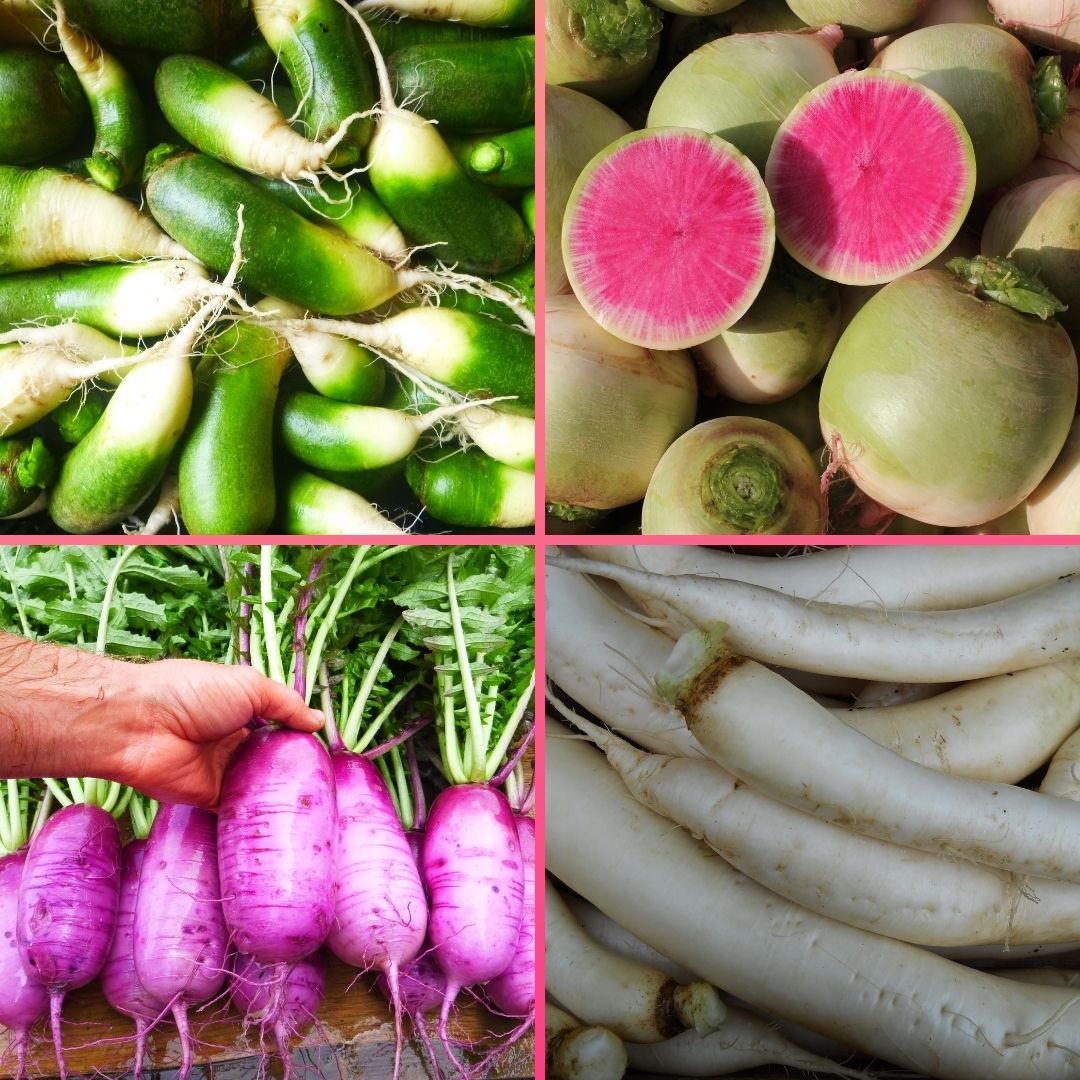All About Winter Radishes and Why You Should Absolutely Try Them
Winter in Maine is arguably bleak.
White snow, bare trees, it is a stark reality. It can also be a stark reality in terms of local food. With most vegetable farm stands and farmers markets shutting down in the fall, many return grudgingly to the grocery store for their veggies.
Recently we were asked,
What time of year do you open up and start selling veggies again?
Wait, you have veggies in the winter?? Do you grow them all in greenhouses?
These are questions we get ALL the time, when we try to explain just what we do here on our farm.
We have veggies grown on our farm organically available for sale 12 months of the year here in Piscataquis county, central Maine!
And I want to share with you one of the brightest things that we have available in bleak mid-winter! Here's to having fun with new veggies while raising your spirits and your immune system!
Winter radishes!

All About Winter Radishes and Why You Should Absolutely Try Them
Winter radishes, also known as storage radishes, are simply different kinds of radishes! Yes, I know we do get conditioned to think that radishes are only one color and only one shape from what is available at the grocery store.
But, you can’t easily have little round red radishes available in the winter. So that’s where the winter radishes come in!
And they're not just beautiful, but good for you, too!
An old Chinese proverb states,
"Eating pungent radish and drinking hot tea lets the starved doctors beg on their knees."
Radishes are low in calories and known to help improve your digestive system and are good sources of potassium, vitamin C and phosphorus.
What are the different kinds of winter radishes?
There are many different kinds of radishes from around the world, in many different colors.
Here’s examples of some of them:
- Japanese Daikon radishes, long Asian radishes also known as mooli in India, that come in different colors and lengths from pure white, to green and white, to purple, to pink!
- Chinese Lu obo radishes are long green radishes
- Watermelon radishes are have light green flesh with an explosion of hot pink interior
- Black Spanish radishes have black skin and a snow white interior
- And there are others out there that we've not tried yet!
What do they taste like and why should I try them?
The taste of winter radishes is similar to summer radishes, often pretty mild to medium in spiciness. The Black Spanish are the spiciest ones we've tried.
The texture is firmer and denser than a summer radish, but still with a satisfying crunch to them, making them great for raw uses.
The colors are extraordinary and exciting used raw!
They expand the diversity of what is available locally from farm-fresh produce in the winter season.
Our Winter CSA members always find them an interesting surprise!
How to use winter radishes?
Winter radishes are super versatile! They can be used raw or cooked in a variety of ways!
Used raw:
- Fermented either on their own or added as an ingredient in Kimchi (my tutorial here)
- Quick pickled (my tutorial here)
- sliced thinly or made into match sticks for dipping and snacking
- sliced thinly and put onto a sandwich with a little salt
- sliced thinly and topped with a little salt and used as an appetizer to get the digestive juices going before a full meal
- grated raw into a salad or slaw (Thai Green Radish Salad found here, or see below)
- spiralized to top a salad
Used cooked:
- braised (Braised Watermelon Radishes recipe found here)
- roasted (basic roasting include chopping, tossing with olive oil, salt and pepper, and roasting at 400 until tender or see below for medley recipe)
- stir-fried with other veggies (Chinese-style Daikon Stir-fry recipe found here)
How do you prepare winter radishes?
- scrub them well
- peel them (optional)
- slice or grate or chop according to recipe
How do you store winter radishes?
Winter radishes are storage radishes and store very well when kept in the right conditions. The best way to keep them is in a perforated plastic bag in your crisper drawer or in your fridge. They want to be cold, below 40 degrees and moist. Not sopping wet which can promote rot, but not just loose in your fridge to get dried out and rubbery.
How do you grow and harvest winter radishes?
- Get seed for winter radishes (they're not easily grown from transplant). Baker Creek or Kitazawa are good sources for lots of more unusual Asian varieties.
- Plant mid-summer, around August 1 in central Maine. Winter radishes don't want to be planted in the spring as they'll bolt to seed more likely.
- Harvest in mid-late October before the ground gets frozen.
- Store at below 40 degrees in a root cellar or fridge in perforated plastic bags or other similar moist but not too moist environment.
How and when to buy winter radishes?
You can't get them from the regular grocery store as far as I know. They may have them at a specialty natural food store. Straight from the farm is the best option, in my opinion! If you join our Winter CSA then you get them in your farm shares automatically, whatever we decide to grow that year. If you're not a CSA member, you are welcome to preorder them as available and pick them up on the farm.
Check out info on how to preorder veggies from our farm here.
New recipe for winter radishes
Because I'm a sucker for new recipes and especially winter slaws, here's a delicious one we just made! Slaws are an easy way to get started with winter radishes!
Sweet Radish Apple Slaw Recipe
In a large mixing bowl, combine:
- 1 Tbsp lemon juice
- 1 Tbsp cider vinegar
- 1 tsp honey
- 3 Tbsp mild flavored oil such as grape seed or sunflower oil
- 1 Tbsp finely chopped onion or 2-3 Tbsp finely chopped shallot
- 2-3 Tbsp finely chopped parsley, optional
- 1 Tbsp finely chopped ginger, optional
Shred with food processor with shredding disk (larger holes) or the largest holes on a box grater:
- 1/2-1 pound winter radishes, peeled and trimmed
- 1 large carrot, peeled
- 1 or 2 crisp apples, peeled and cored (the apple could be chopped up instead of shredded if you prefer, which is how I do it for bigger bites of apple)
Toss all ingredients together. Season with salt and pepper to taste. Cover and chill for an hour before serving.
Or try this:
Roasted Radishes and Root Vegetables with Rosemary and Mustard
- 1 pound winter radishes and/or other root vegetables, chopped into 1-2" pieces
- 3 Tbsp olive oil (and more for drizzling)
- A few good sized sprigs of fresh rosemary, stem removed, and chopped (or use dried)
- Kosher salt
- ½ tsp mustard seeds
- 3 Tbsp white wine
- 2 Tbsp water
- 1 tsp prepared coarse grain mustard
- salt and pepper, to taste
- Toss vegetables with rosemary and olive oil. Place vegetables on a baking pan and sprinkle with salt. Roast for 30-40 minutes, until they are soft and have begun to brown, but are not dried out. Remove from oven.
- While vegetables are cooking, make your dressing: Toast mustard seeds. After about 30 seconds, when they begin to pop, add white wine and water. Turn heat to low, and cook until most of the liquid has evaporated. Put in small jar, add 2-3 TBLS olive oil, prepared mustard, salt and pepper, and whisk.
- Top roasted veggies with dressing and serve warm.



Add new comment
Comments (1)
Winter Radishes
Fri, 2021-02-19 16:52